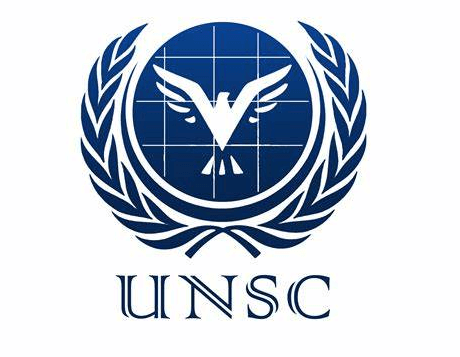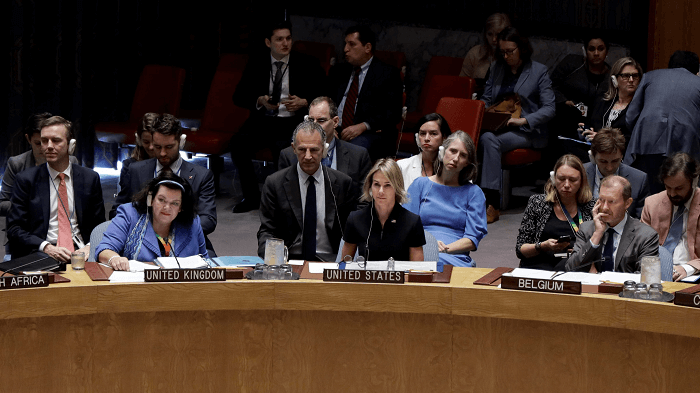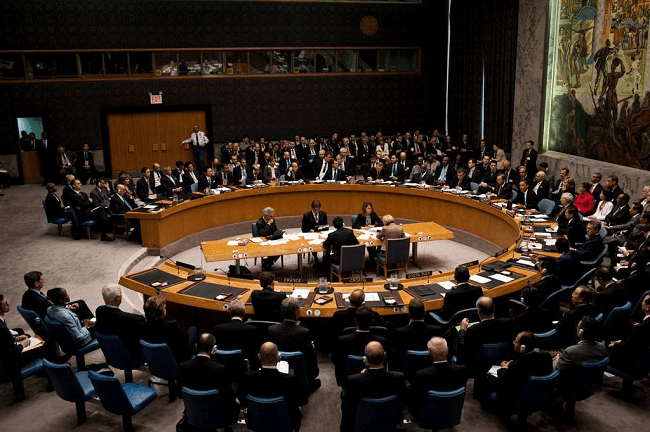What is the full form of UNSCUNSC: United Nations Security CouncilUNSC stands for United Nations Security Council and is one of the six significant organizations of the U.N. Initiated sometime during World War II, the United Nations Security Council (UNSC) today includes fifteen members, of which five are permanent. Every month, the company's contributors switch off to safeguard the president. 
The Security Council often meets in a special room of the United Nations Conference Center in New York City. It has the authority to implement international sanctions, plan peacekeeping missions, and direct navy operations. The UNSC is the only U.N. body having the power to impose binding legal obligations on member states. The Security Council was first created with the U.N.'s reform to address the League of Nations' failures in maintaining international peace. After its first session on January 17, 1946, the Cold War between the United States and the Soviet Union caused it to be mostly paralyzed for a considerable amount of time. (And allies of both.) However, it authorized missions to maintain the peace in Cyprus and military actions in the Sinai Peninsula, West New Guinea, and the Congo Crisis. After the collapse of the Soviet Union, the size of U.N. peacekeeping operations significantly increased. The Security Council then approved the largest military and peacekeeping missions in Kuwait, Namibia, Cambodia, Bosnia and Herzegovina, Rwanda, Somalia, Sudan, and the Democratic Republic of Congo. Of the fifteen permanent members of the Security Council, five are from China, France, Russia, the United Kingdom, and the United States. These were the key victorious countries after World War II (or their successor states). U.N. peacekeepers are made up of armed troops voluntarily provided by member nations, paid separately from the main U.N. budget, and are typically used to execute Security Council resolutions. Permanent contributors can veto (block) any key Security Council decision, including the admission of new U.N. members or potential Secretary-General Candidates. This veto power is no longer carried over to votes or items in the General Assembly or in emergency sessions of the General Assembly [citation needed]. The remaining ten participants are chosen on a regional basis and serve terms of two years. The leadership of the Group is rotated monthly among its members. There have been 12 peacekeeping operations as of November 2021, with more than 87,000 people from 121 nations and total funding of nearly $6.3 billion. History of UNSCThe ICRC and the Hague Conventions of 1899 and 1907 were among the treaty bodies and international conferences created before the establishment of the United Nations to resolve international disputes. The League of Nations was founded at the Paris Peace Conference to maintain international peace in the wake of the terrible toll that World War I had taken. This business successfully settled certain border conflicts and built international institutions for things like postal service, aviation, and opium control, some of which would eventually be included in the U.N. However, the League was notably underrepresented by the U.S., the USSR, Germany, and Japan, among other strong countries, and did not adequately represent colonized peoples, who at the time made up approximately half of the world's population. During World War II, Winston Churchill, Chiang Kai-shek, and Franklin D. Roosevelt all gathered in Cairo for the Cairo Conference. In February 1945, British Prime Minister Winston Churchill, US President Franklin D Roosevelt, and Soviet General Secretary Joseph Stalin all attended the Yalta conference. The name "United Nations" was first officially used when 26 countries signed the declaration. The following day, representatives from 22 other countries also signed. It did not affect the Japanese invasion of China in 1937, the Japanese occupation of Manchuria in 1931, the Second Italo-Ethiopian War in 1935, or the outbreak of the Nazi advance under Adolf Hitler. A further 21 states had signed by March 1, 1945. The term "Four Powers" was used to describe the four major Allied nations at the time: the U.S., the U.K., the USSR, and the Republic of China. It developed into the core of the Security Council, one of the U.N.'s government departments. When the "Big Four" Allies-the Soviet Union, the United Kingdom, the United States, and the Republic of China-met in Washington, D.C. for the Dumbarton Oaks Conference to discuss the U.N.'s structure in the middle of 1944, the Security Council's composition quickly rose to the top of the list of points of contention. France, the People's Republic of China, the Soviet Union, the United Kingdom, and the United States are the Security Council's permanent members. The chiefs of the Soviet and British delegations originally objected to the American request to include Brazil as a sixth member. Soviet and British delegations' heads opposed the U.S. proposal to include Brazil as a sixth member. The most contentious topic at Dumbarton and in later talks was the permanent members' veto authority. The American, British, and Russian delegations at the Yalta conference in February 1945 decided that any of the "Big Five" may reject any motion with the Council's assistance, but not a procedural decision. This meant that the permanent participants could no longer stop debate on a resolution. While the British delegation claimed that countries shouldn't be able to reject resolutions to conflicts to which they had been a party, the Soviet delegation contended that each nation should have an absolute veto that might wish to prohibit topics from ever being addressed. Fifty states and non-governmental organizations interested in creating the United Nations Charter participated in the U.N. Conference on International Organization, which began on April 25 in San Francisco. At one point in the meeting, H. V. Evatt of the Australian delegation pushed for a similar ban on permanent Security Council members' ability to veto measures. His proposal was vetoed twenty votes to ten because there was worry that rejecting the strong veto would lead to the conference failing. The Charter was ratified by a majority of the other 46 signatories and the five Security Council members who were then permanent members on October 24, 1945, creating the U.N. officially. The Council first met on January 17, 1946, at the Westminster Abbey building in London, England. UNSC: Roles and ResponsibilitiesSaving future generations from the scourge of war used to be the Security Council's primary goal. According to UN Charter Article 24, the Security Council is primarily responsible for restoring international peace and security. In reality, the Security Council is the only international body with authority to adopt enforceable resolutions to preserve world peace and security. To maintain equilibrium and peace, it may, for instance, give the go-ahead to use sanctions or force. UNSC: Membership
The United States, France, the Soviet Union, the United Kingdom, and the Republic of China are the Security Council's five permanent members (Taiwan). The U.N. General Assembly selects the other ten non-permanent participants for the tenure of two years. The five permanent members of the Security Council have the power to veto any major resolution; this allows permanent members to block approval of a decision but no longer stops or ends the debate. In addition to the five permanent members, the United Nations Security Council also includes temporary members that rotate into their seats based on geography. Non-permanent MembersBriefings on global security may raise concerns for non-permanent members as well. The United Nations Security Council also includes temporary members that rotate into their seats according to the geographic region and the five permanent members. For the first 20 years of the Security Council, there were only six non-permanent members: Australia, Brazil, Egypt, Mexico, the Netherlands, and Poland. The number of non-permanent participants was once increased to 10 in 1965. The ten non-permanent contributors are chosen by the U.N. General Assembly for two-year mandates that begin on January 1 and are renewable five times a year. A candidate must get at least two-thirds of the total votes cast to win a seat; however, if two candidates are closely matched, there may be a tie. After three months and 154 rounds of voting, the 1979 impasse between Cuba and Colombia was resolved; both parties ultimately gave up and supported Mexico as a compromise option. Outgoing members are not eligible for immediate re-election. "In odd-numbered periods, two members from Western Europe and other nations are included, as well as one representative each from Asia-Pacific, Africa, Latin America, and the Caribbean." Candidate nations typically break intractable impasses in favor of a third-member nation. Italy and the Netherlands failed to obtain the two-thirds majority in the 2016 United Nations Security Council election. As a result, they decided to end the Western European and Other Group's tenure. Two participants consented to do so for the first time in more than five years. PresidentThe duties of the Security Council's president include setting the agenda, running its meetings, and managing crises. The president has the authority to issue Presidential Statements and Notes, which are used to make statements of purpose that the Security Council can then act upon. Meeting LocationThe Security Council does not have set times for its meetings as the General Assembly does. Each Security Council member maintains a presence at U.N. headquarters in case an emergency meeting is necessary. The United Nations conference building in New York has a dedicated room where the Security Council meets regularly. The Norwegian architect Arnstein Arneberg created the room as a gift from Norway. The 1952 United Nations Security Council mural by Norwegian artist Per Krohg shows a phoenix emerging from its ashes as a metaphor for the world's rebirth following World War II. The Security Council has also convened in Geneva, Switzerland, Addis Ababa, Ethiopia, Nairobi, Kenya, and Panama City, Panama. As part of the U.N. Capital Master Plan, the Security Council's chamber underwent repairs in March 2010; the body was relocated to a temporary location in the General Assembly Building. The chamber's true donor, Norway, provided the $5 million needed to complete the renovations. The room reopened on April 16, 2013. Member state representatives are seated at a horseshoe-shaped table, with the president in the middle, the secretary on the right, and the deputy minister on the left. Two places are left at the ends of the table for guest speakers, and the representatives are seated around the table in alphabetical order, starting with the president. As the presidency rotates each month, the members' sitting is reversed. Because Security Council sessions are open to the public, delegations utilize the chamber to express their viewpoints in unusual ways, including by walking out. Consultation Room
Much of the Security Council's work is done in "informal discussions" behind closed doors due to the public monitoring of the Security Council Chamber. The Security Council Chamber was built with assistance from West Germany in 1978. What was initially intended for "informal discussions" has since evolved into the Council's primary meeting location. In 1994, the French Ambassador complained to the Secretary-General that "open meetings, which used to be the norm, are increasingly unusual and devoid of substance: Everyone knows that when the Council meets in an open meeting, everything is predetermined," rather than formal council meetings. The Russian Ambassador described the renovated discussion room as "quite simply, the most appealing venue in the entire diplomatic world" after Russia sponsored the refurbishment in 2013.
Next TopicFull Form
|
 For Videos Join Our Youtube Channel: Join Now
For Videos Join Our Youtube Channel: Join Now
Feedback
- Send your Feedback to [email protected]
Help Others, Please Share










